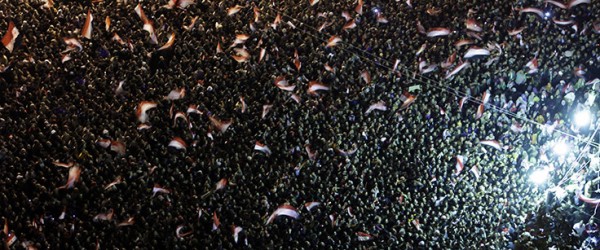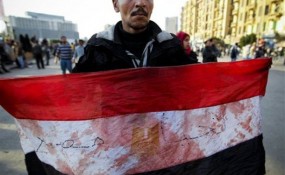
The Eighteen Day Revolution
Commentary, Essays, Nostalgiaby Laura Templeton
This is a revolution. This is what the ‘power of the people’ looks like. After eighteen days of vehement protests, President Hosni Mubarak was ousted by the people of Egypt. Thousands of people gathered in Egypt’s two largest cities: Cairo and Alexandria, putting an end to Mubarak’s thirty year autocratic reign.

After three decades of writhing under Mubarak’s rule, Egyptians finally organized a powerful protest, channelling years of oppression into change. The people’s desire to oust Mubarak, and their success in doing so, was fuelled by his authoritarian and anti-democratic policies.
Initially, Mubarak was considered a man of the people. His progressive, pro-western, modernist leadership was held in high esteem and he was considered a unifying force in Egypt; however, his policies were highly anti-democratic and soon his tyrannical tactics gravitated toward his own people.

In the past, dissidents and political activists were jailed without trials or legitimate reasons, for speaking ill of the administration’s policies. Opposing political parties have been, again without legitimate reason, nullified; multiple elections have been manipulated in Mubarak’s favour. Venality has slithered amongst, entwined, and constricted the government’s economical and ethical decisions – all as a ploy to maintain Mubarak’s position of power, while the national economy was in decline and as unemployment was on the rise.
This is a man who had been convincing Egyptians, along with the rest of the world, that his corrupt, authoritarian rule was necessary. According to him, it was his anti-democratic policies that had kept radical Muslims at bay. Yet, during the revolutionary protests in Cairo, Mubarak supposedly hired thugs to beat on, and annihilate, anti-government protestors. Since the beginning of the protests, approximately three-hundred people have been killed across the country.
February 2nd, nine days into the protest, government supporters rode into Tahrir Square brandishing whips and sticks. Simultaneously, an inferno of firebombs were thrown from rooftops into crowds of protestors. Three people died and nearly six-hundred were injured as a result. It‘s suspected that Mubarak hired these people to assault, and hopefully silence, the protestors and the movement.
The protest started to resemble a war zone. With anti-Mubarak protestors hunkering behind sheets of metal, throwing firebombs and bricks at Mubarak supporters on the rooftop above.
Some pro-government supporters waved machetes at protestors. The subway station was used as a makeshift prison for attackers that the protesters successfully caught, tying their hands and legs together. Locking them inside. Front lines were formed and battles were fought. From fistfights to firebombs.
Other anti-Mubarak protestors remained stationed at Tahrir Square, weeping and praying.
The military held a neutral position outside of the square and didn’t intervene with the actual protests. It recognized and respected the rights of its people, “To the great people of Egypt, your armed forces acknowledge the legitimate rights of the people…we have not and will not use force against the Egyptian people.”

This support was groundbreaking for the anti-government protestors. It banished fear from the state and empowered them, encouraging more people to join the movement.
Hundreds of thousands of protestors occupied Tahrir Square for eighteen days, defying their curfew while doing so. Despite the brutality that occurred between Mubarak’s supporters and the protestors, the Square was enthusiastic with festive-like songs and chants. Chaos could not hinder the sanguinity of this realm, only strengthen it.
“Egypt is free! Egypt is free!” Protestors at Tahrir Square, Cairo celebrated as Vice President Omar Suleiman recited Mubarak’s speech of resignation on Friday February 18th. This speech was truly inspirational, and a representation of the power that people around the world possess.
“These people have the ability to overcome the hardships and confront challenges. We will work in the spirit of team and with the solid determination of Egyptians, who are unshakeable.”
This is but a ripple in the wave of revolution across the Middle East, which was ultimately triggered by last month’s ousting of the President of Tunisia. Middle Eastern countries alike are protesting to overthrow autocratic leaders.
“Let us walk together toward a new road that achieves the hopes of the people and provides them with a secure, stable, and filled with love for the nation, that deserves to be protected.”






















